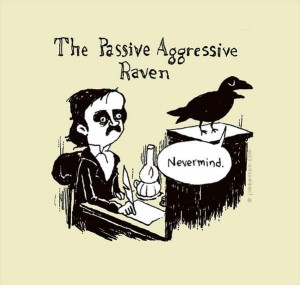We a ll have experienced it at some point in life: passive aggressive behavior. Defined as the indirect expression of hostility, passive aggressive behavior can feel omnipresent at the workplace if leaders don’t actively work to prevent it. It can take many forms including a negative attitude, procrastination, stubbornness, sarcasm, gossip, withdrawal, unusual behavior, or the repeated failure to complete tasks. If passive aggressive behavior isn’t addressed, the costs to a team or an organization can be great. Decision making slows down. Resentment between team members grows. Communication breaks down. Potential risks are not identified. The organization becomes incapable of functioning at the highest level possible, and for individuals within the organization, the unaddressed conflict festers into animosity, disloyalty, stress, and sometimes departure.
ll have experienced it at some point in life: passive aggressive behavior. Defined as the indirect expression of hostility, passive aggressive behavior can feel omnipresent at the workplace if leaders don’t actively work to prevent it. It can take many forms including a negative attitude, procrastination, stubbornness, sarcasm, gossip, withdrawal, unusual behavior, or the repeated failure to complete tasks. If passive aggressive behavior isn’t addressed, the costs to a team or an organization can be great. Decision making slows down. Resentment between team members grows. Communication breaks down. Potential risks are not identified. The organization becomes incapable of functioning at the highest level possible, and for individuals within the organization, the unaddressed conflict festers into animosity, disloyalty, stress, and sometimes departure.
Team leaders and managers must be proactive by preventing passive aggressive behavior quickly in order to avoid the unintended consequences. Here are a series of strategies for handling passive aggressive behavior effectively in a team or organization:
- As a leader, reflect on your own feelings around conflict. Do you avoid conflict? Do you address conflict at the appropriate moment? Spend some time thinking about the biases you might hold towards conflict and resolution, and start developing a plan for addressing conflict more directly. Your understanding and ability to address conflict is 50% of the solution.
- Make team members feel comfortable openly expressing contrasting views. Explicitly encourage engagement and develop ground rules to maintain professionalism and healthy disagreement. Anger should be expressed in a factual, non-judgmental way. For example: “I’m concerned that we are not sharing all of our opinions. I would like everyone to share their thoughts without be concerned about disagreeing.”
- Keep the conversation focused on specifics – not generalities. It is important that everyone is clear about the issue at hand, and don’t allow others to turn the specific concern into a conflated generalization (e.g., “You’re always making these mistakes!”,”This product doesn’t make sense!”). The focus should be on a specific action, decision, or problem.
- When opposing viewpoints are provided, spend time discussing them. Analyze all aspects of the alternative viewpoint and if it seems like an unpopular viewpoint, provide it credibility without necessarily agreeing. For example: “I didn’t see it that way. Can you explain your reasoning?”
- Quash all passive aggressive behaviors happening outside of meetings or moments of conflict resolution and decision making. For example, if after a meeting employees attempt to share unvoiced thoughts or concerns, let them know that you expect these ideas to be shared during the meeting. Don’t allow the back channels to exist.
- Be aware of people using sarcasm or humor to avoid important discussions. You might say, “I get the sense we’re using humor to avoid a serious discussion. What’s making this conversation difficult?”
- Watch for negative body language, as that is often the first sign of disagreement or anger. Are people folding their arms or facing their bodies away from others? Are some engaging in the infamous eye-rolling? If so, address the behavior immediately. Try something like, “You seem to be disengaging from this discussion. Is something on your mind?”

Recent Comments